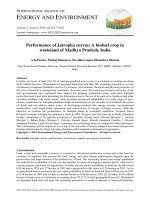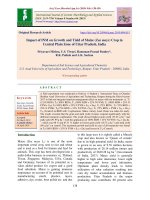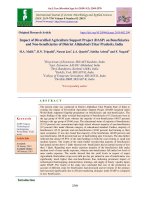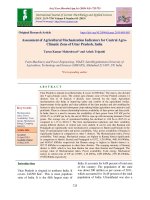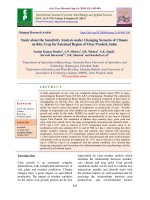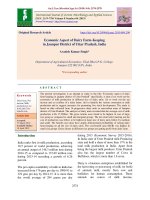Macrofungal diversity of north-eastern part of Uttar Pradesh (India)
Bạn đang xem bản rút gọn của tài liệu. Xem và tải ngay bản đầy đủ của tài liệu tại đây (1.17 MB, 16 trang )
Int.J.Curr.Microbiol.App.Sci (2019) 8(2): 823-838
International Journal of Current Microbiology and Applied Sciences
ISSN: 2319-7706 Volume 8 Number 02 (2019)
Journal homepage:
Original Research Article
/>
Macrofungal Diversity of North-Eastern Part of Uttar Pradesh (India)
Ravinder Pal Singh1*, Abihjeet S. Kashyap2, Aradhana Pal1,
Pooja Singh1 and N.N. Tripathi1
1
Bacteriology and Natural Pesticide Laboratory, Department of Botany,
DDU Gorakhpur University, Gorakhpur-273009, (U.P.), India
2
ICAR-NBAIM Mau (U.P.), India
*Corresponding author
ABSTRACT
Keywords
Macrofungal
diversity, Climatic
condition,
Gorakhpur
Article Info
Accepted:
07 January 2019
Available Online:
10 February 2019
Present study was done in North-Eastern part of Uttar Pradesh (India) which is home to
diverse form of macrofungal species, some of which are highly edible and generally used
by local peoples as food and other medicinal purpose. Species composition and species
diversity of macrofungi were examined in 7 Tehsils of Gorakhpur district. The fruiting
bodies of macrofungi were collected between 2014-2016 during different seasons, but
maximum occurrence of macrofungi was found in rainy season. During extensive field
survey 30 macrofungal samples were collected and identified which belonging to 23
genera and 16 families on the basis of their morphological and microscopic study. These
macrofungi were observed in humid, calcareous, sandy soil and on wood log, wood, leaf
litter, leaf heaps, troops of rotten wood, decaying wood log as well as on termite nests. The
collected macrofungi were well photographed, preserved in dry as well as in wet condition
for the further study. Present study indicates that the variation in climatic condition of
Gorakhpur made it possible for the prosperity and unevenness of macrofungi in this area.
Andrew et al., 2013). Macrofungi studies
have long been of interest to scientists as well
as the public due to their important roles in
human life, such as their beneficial and
harmful effects on forests, their use in the
pharmacology industry, and the mass
production of cultivated fungi in the food
industry, as well as their vital role in
biodegradation (Stojchev et al., 1998).
Mushrooms are economically important since
they serve as food, medicine, biocontrol
agents, chemical producers of bioactive
Introduction
Fungi are a group of heterotrophic organisms
that consist of a thallus, an assemblage of
vegetative cells not forming tissue in the
functional sense, and therefore not having
differentiated organs. They are one of the
most diverse groups of organisms on earth,
and constitute a significant part of terrestrial
ecosystems. They form a large share of the
species richness and are key-players in
ecosystem processes (Senn-Irlet et al., 2007,
823
Int.J.Curr.Microbiol.App.Sci (2019) 8(2): 823-838
compounds used in the pharmaceutical and
many other industries.
Gola, Khajni, Sadar and Sahjanwa of
Gorakhpur district were conducted between
2014-2016 for the collection of macrofungi.
Regular field trips were made for collection of
macrofungi but it was more frequent during
(June to September) monsoon season.
Collected
macrofungi
samples
were
photographed in their natural habitat and their
morphological characters were noted. The
habitats including ecological parameters viz.,
vegetation composition, soil type, humidity,
temperatures and time with macroscopic
characters of the specimens were also noted.
Macrofungi are useful in the bioremediation
of industrial waste and the accumulation of
heavy metals from the environment
(Demirbas 2000). Lignicolous macrofungi
also have secondary metabolites which
expressed significant effects such as
antibacterial activity (Kalyoncu et al., 2010).
They can also be grown and used as a cash
crop.
Macrofungi include well-known groups that
have been described by popular terms such as
‘gilled fungi’, ‘cup fungi’, ‘bracket fungi’,
‘puffballs’, and ‘truffles’. These terms reflect
the morphological diversity that is
encountered
within
the
macrofungi.
Ecologically, macrofungi can be classified
into three groups: the saprophytes, the
parasites and the symbiotic (mycorrhizal)
species. Most terrestrial macrofungi are
saprobes or mycorrhizal symbionts, but some
are pathogens of plants or fungi. Macrofungi
fruiting on woody substrata are usually either
saprobes or plant pathogens (Mueller et al.,
2007).
The macrofungal samples were brought to the
laboratory
for
further
microscopic
examination and preserved in the wet and dry
condition (Singh et al., 2016). In dry
preservation the collected samples were well
dried and packed in wax-paper bags wrapped
with aluminum foil to prevent external
infection and intermixing of the spores and
labeled. Collected macrofungi were identified
on the basis of their morphological and
microscopic characters and confirmed by
using the relevant literatures (Jordan, 1995;
Vishwakarma et al., 2011; Zheng and Lui,
2008; Kumar and Sharma 2009). All the
macrofungal specimens were deposited to the
herbarium of Department of Botany, DDU
Gorakhpur University, Gorakhpur, (U.P.)
India.
Mushrooms are widespread in nature and they
remain the earliest form of fungi known to
mankind. Mushrooms appear to be collected
and consumed during almost the entire year,
but most fungi are collected during the rainy
seasons, suggesting the importance of rainfall
patterns in fungal phenology. The goal of this
paper is to turn the attention on the
occurrence of several saprotrophic terrestrial
agarics confined to naked humose soil
observed in Gorakhpur district.
Results and Discussion
During present investigation a total of 30
macrofungi samples were collected which
belonging to 23 genera and 16 families. The
most dominant families were Polyporaceae
and Tricholomataceae having 5 species each
followed by Fomitopsidaceae having 4
species; Cantharellaceae, Ganodermataceae
and Hygrophoraceae having 2 species each
while
Cordycipitaceae,
Xylariaceae,
Pezizaceae,
Pyronemataceae,
Hyphodermataceae,
Strophariaceae,
Materials and Methods
Collection of macrofungi
Exhaustive
Bansgaon,
surveys in 7
Chauri-Chaura,
Tehsils viz.,
Campierganj,
824
Int.J.Curr.Microbiol.App.Sci (2019) 8(2): 823-838
Albaratrellaceae,
Sparassidiaceae,
Meruliaceae and Hymenochaetaceae having
one species each. Out of 30 identified
macrofungi 7 were found to be edible, 22
were inedible while one was poisonous.
Collection
examined:
Uttar
Pradesh,
Gorakhpur district, Khajni Tehsil, Khajni
block, Belipaar village. Ravinder Pal Singh,
DDUNPL-276.
Specimen examined: Macroscopic and
microscopic features agree well with the
description given by Koyani et al., (2016).
The information regarding the species name,
family, edibility and date of collection of
macrofungi are given in Table 1 (Fig. 1 and
2).
Peziza ampliata Pers.: Fr.
Description of collected macrofungi given
below with their photographs
Description: Fruit body 1-3 cm in diameter
and 1-2 cm tall, apothecial upper (hymenial)
surface cinnamon brown, smooth, outer
(lower) surface more pallid with darker mealy
dots, at first almost vesicular, becoming more
cup-shaped with a denticulate margin, sessile.
Flesh brown, brittle and thin. Spores 18-20 X
10-22 µm, hyaline, reticulate, ellipsoid, nonseptate, uniseriate, 2 droplets, inedible.
Cordyceps canadensis Ellis & Everhart
Description: Fruit body 3-10 cm high, the
fertile head is oval to subglobose, chestnut
brown to blackish, set on a tough yellowolivaceous stalk up to 1cm thick. Spores 2050 X 3-5 µm, smooth, hyaline, ellipsoid.
Habitat mainly in decay wood or cow dung,
inedible.
Collection
examined:
Uttar
Pradesh,
Gorakhpur district, Campierganj Tehsil,
Campierganj block, Veer Bahadur Singh
Park. Ravinder Pal Singh, DDUNPL-279.
Collection
examined:
Uttar
Pradesh,
Gorakhpur district, Sadar Tehsil, Khorabar
block, Kushmi jungle. Ravinder Pal Singh,
DDUNPL-272.
Specimen examined: Macroscopic and
microscopic features agree well with the
description given by Jordan (1995).
Specimen examined: Macroscopic and
microscopic features agree well with the
description given by Ginns 1988.
Cheilymenia stercorea (F H Wigg.: Fr.)
Boud
Xylaria carpophila (Pers.: Fr.) Fr.
Description: Fruiting body cup shaped 0.2-0.3
cm across, upper surface reddish orange,
fading to yellowish; undersurface similarly
colored or paler, with bristle-like hairs
ranging from brownish to yellowish, flesh
thin and insubstantial. Saprobic on the dung
of domestic animals (primarily horses and
cows) and occasionally reported on the dung
of wild animals; growing alone or
gregariously, spring through fall, or in winter
in warmer climates. Spores 14-18 X 8-10 µm,
elliptical, smooth, inedible.
Description: Fruiting body 0.2-0.3 cm in
diameter and 2-5 cm tall, upper stromal
surface whitish becoming black-tipped at
maturity, lower sterile parts black and downy,
antler-shaped, compressed, perithecia black,
sub-spherical, fully embedded in the stromal
tissue and arranged in a single dense layer just
beneath the surface towards the apex. Flesh
white and hard. Spores 11-14 X 5-6 µm,
chocolate, smooth, reniform, with distinct
cleft on one side, non-septate, uniseriate, 1-2
droplets, inedible.
825
Int.J.Curr.Microbiol.App.Sci (2019) 8(2): 823-838
Collection
examined:
Uttar
Pradesh,
Gorakhpur district, Sadar Tehsil, Khorabar
block, Kushmi jungle. Ravinder Pal Singh,
DDUNPL-280.
Sardar Nagar block, Saraya village. Ravinder
Pal Singh, DDUNPL-284.
Specimen examined: Macroscopic and
microscopic features agree well with the
description given by Jordan (1995).
Specimen examined: Macroscopic and
microscopic features agree well with the
description given by Jordan (1995).
Albatrellus flettii Mores ex Pouzar
Hyphodontia sambuci (Pers.) Erikss
Description: Pileus 6-7 cm across; more or
less circular in outline; loosely convex, flat or
irregular, occasionally fused, dry, smooth,
finely velvety, or with tiny scales in patches,
blue, gray or grayish blue, becoming brown,
brownish. Stipe 2.5-7 cm long; up to 2 cm
wide, sometimes a little off-center; blue,
discoloring to grayish or brownish with age;
smooth or rugged. Pores descending the stipe,
pale blue or gray, becoming grayish or
brownish, 2-3 angular pores per mm, tubes 4
to 5 mm deep. Spores 4-6 X 3-5 µm, smooth;
broadly elliptical or subglobose, inamyloid.
Gloeoplerous hyphae absent. Choicely edible.
Description: Fruit body variable in diameter
and 0.05-0.1 cm thick. Fruiting body white,
resupinate, with irregular margin, the
hymenial
surface
having
a
chalky
consistency, flesh white and extremely thin.
Spores hyaline, smooth, ellipsoid, nonamyloid, 5-7 X 4-5 µm, inedible.
Collection
examined:
Uttar
Pradesh,
Gorakhpur district, Sahjanwan Tehsil,
Sahjanwa block, Ranipaar village. Ravinder
Pal Singh, DDUNPL-283.
Specimen examined: Macroscopic and
microscopic features agree well with the
description given by Jordan (1995).
Collection
examined:
Uttar
Pradesh,
Gorakhpur district, Chauri Chaura Tehsil,
Sardar Nagar block, Saraya village. Ravinder
Pal Singh, DDUNPL-285.
Pholiota adiposa (Fr.) Kummer
Specimen examined: Macroscopic and
microscopic features agree well with the
description given by Zheng and Liu (2008).
Description: Pileus 5-12 cm in diameter,
golden-yellow covered with rust, flattened,
gelatinous
scales,
convex,
becoming
expanded, very viscid. Flesh pallid yellow
and firm. Stipe 2-5 cm tall and 0.5-1 cm thick,
at first concolorous with cap, becoming more
rust, smooth above ring, with bands of rust
scales below, more or less equal, typically
curved, very viscid. Ring fragile and
ephemeral, sub-apical. Flesh yellow, full and
tough. Gills yellow, becoming rust at
maturity, adnate, crowded. Spores 5-6 X 3-4
µm, rust or reddish-brown, smooth, ellipsoid,
inedible.
Cantharellus cibarius Fr.
Description: Pileus 4-5 cm in diameter,
usually funnel shaped, has a irreugular
margin. Colour varies from light yellow to
deep egg-yolk yellow, but some times a fine
white bloom masks the background colour.
Stipe 2-2.5 cm long and 0.3-0.5 cm thick,
merging into the cap, colour paler than the
cap. When growing in clumps, as is often the
case, the stem of chanterelles are often curved
and occasionally joined together near the
base. Not strictly gills at all, the wrinkled
Collection
examined:
Uttar
Pradesh,
Gorakhpur district, Chauri ChauraTehsil,
826
Int.J.Curr.Microbiol.App.Sci (2019) 8(2): 823-838
veins on the underside of the cap. The veins
are very thick and decurrent, extending well
down the stem; they are straight near to the
stem but forked and more sinuous towards the
edge of the cap. Spores 7-11 X 4-6 µm,
ellipsoid, smooth, inamyloid, hyaline,
inedible.
Sparassis crispa (Wulf) Fr.
Description: Fruiting body 10-40 cm in
diameter, cremish to yellowish in color, sub
spherical comprising large number of
flattened wavy lobes arising from thin and
short rooting stem. Stipe brown in color,
branched, woody.
Collection
examined:
Uttar
Pradesh,
Gorakhpur district, Sadar Tehsil, Chargawan
block, Maniram village. Ravinder Pal Singh,
DDUNPL-288.
Spore bearing surface ochraceous. Spore 5-6
X 4-4.5 µm, ellipsoid, non amyloid, hyaline.
Spore print whitish. Flesh crispy, elastic and
ochraceous. Edible.
Specimen examined: Macroscopic and
microscopic features agree well with the
description given by Vishwakarma et al.,
(2011).
Collection
examined:
Uttar
Pradesh,
Gorakhpur district, Bansgaon Tehsil, Gagha
block, Rampur village. Ravinder Pal Singh,
DDUNPL-289.
C. subalbidus Smith & Morse
Specimen examined: Macroscopic and
microscopic features agree well with the
description given by Kumar and Sharma
(2009).
Description: Pileus 7-10 cm dia., broadly
convex to flat, develops central depression
and becoming irregularly shaped with age,
margin become uplifted, wavy and lobed,
bald or nearly felty when young, dry, whitish,
bruising and discolouring yellowish with age.
Stipe 3-4 cm long, 1-2 cm thick, tapering
toward base, solid, whitish, bruising and
discolouring yellowish with age.
Fomitopsis pinicola (Sw.) P. Karst.
Description: Fruiting body 15-16 cm wide,
semicircular, convex to hoof shaped, hard,
tough, woody, smooth, wrinkles with age, cap
surface usually red to reddish brown with a
white or yellow margin. Stem absent. Pore
surface cream colored and it does not bruise
brown, 3-5 pores per mm.
Undersurface with false gills that run down
the stem, often with cross veins, white,
bruising and discolouring yellowish with age.
Spores 8-9 X 4.5-5 µm, smooth, ellipsoid,
inamyloid. Spore print white. Flesh white,
discolouring yellowish with age. Edible.
Spores 6-8 X 4-4.5 µm, cylindrical, inamyloid
and smooth. Spore print yellowish. Flesh
white and leathery to woody, inedible.
Collection
examined:
Uttar
Pradesh,
Gorakhpur district, Sadar Tehsil, Chargawan
block, Maniram village. Ravinder Pal Singh,
DDUNPL-287.
Collection
examined:
Uttar
Pradesh,
Gorakhpur district, Khajni Tehsil, Khajni
block, Belipaar village. Ravinder Pal Singh,
DDUNPL-290.
Specimen examined: Macroscopic and
microscopic features agree well with the
description given by Jordan (1995).
Specimen examined: Macroscopic and
microscopic features agree well with the
description given by Flores et al., (2014).
827
Int.J.Curr.Microbiol.App.Sci (2019) 8(2): 823-838
Specimen examined: Macroscopic and
microscopic features agree well with the
description given by Tiberius and Cătălin
(2012).
P. stiptica (Pers.) Jülich
Laetiporus sulphureus (Bull.) Murrill
Description: Fruiting body 5-30 cm across
and up to 20 cm deep and 3 cm thick; fanshaped to semicircular or irregular; more or
less planoconvex; smooth to finely wrinkled;
bright yellow to bright orange when young,
frequently fading in maturity and with direct
sunlight. Flesh thick; soft and watery when
young, becoming tough, eventually crumbling
away; white to pale yellow. Stipe absent;
Pores yellow; with 2-4 circular to angular
pores per mm; tubes 4 to 5 mm deep. Spores
5.5-7 X 3.5-5 µm; smooth, elliptical to ovoid,
inamyloid. Edible.
Description: Fruiting body 2-8 cm in
diameter, 1-3 cm thick, white, upper surface
sometimes bristly tomentose, with slight
concentric zonation and radial wrinkling,
margin somewhat wavy, sessile, broadly
attached, flesh white, fibrous, soft. Pores
white, small, at first rounded or slightly
angular on vertical surfaces, 3-4 per mm,
tubes concolorous, 5-8 mm deep. Spores 3.2-4
X 2-2.5 µm, ellipsoid, smooth, hyaline, non
amyloid. Spore print whitish, inedible.
Collection
examined:
Uttar
Pradesh,
Gorakhpur district, Campierganj Tehsil,
Campierganj block, Campierganj Jungle.
Ravinder Pal Singh, DDUNPL-291.
Collection
examined:
Uttar
Pradesh,
Gorakhpur district, Khajni Tehsil, Khajni
block, Madan Pura village. Ravinder Pal
Singh, DDUNPL-292.
Specimen examined: Macroscopic and
microscopic features agree well with the
description given by Chandulal et al., (2013).
Specimen examined: Macroscopic and
microscopic features agree well with the
description given by Tiberius and Cătălin
(2012).
Postia caesia (Schard.: Fr.) Karst.
Description: Fruiting body 1-6 cm in diameter
and 0.2-1 cm thick, at first whitish, becoming
increasingly blue with age, occasionally with
brownish tinge, upper surface finely hairy,
with slight concentric zonation and radial
wrinkling, margin somewhat wavy, sessile
narrowly attached. Flesh whitish, elastic and
tough. Pores whitish, small, at first rounded or
slightly angular, lacerate on vertical surface,
4-6 per mm. tubes concolorous, 4-6 mm deep.
Spores 4-5 X 1.5-2 µm, hyaline, smooth,
cylindrical-ellipsoid or allantoid, amyloid
with droplets, inedible.
Phlebia cornea (Bourd. & Galz.) Parm.
Description: Fruiting body variable in
diameter and 0.05-0.2 cm thick, cream with
grey and ochraceous tinges, resupinate,
irregular patches with distinct margins, the
hymenial surface irregularly warty. Flesh
cream, when damp, faintly thin, waxy and
soft, when dry, membranous and tough.
Spores 7.5-12 X 3.5-5.5 µm, hyaline, smooth,
ellipsoid-cylindrical,
non-amyloid,
with
numerous of droplets, inedible.
Collection
examined:
Uttar
Pradesh,
Gorakhpur district, Campierganj Tehsil,
Campierganj block, Campierganj Jungle.
Ravinder Pal Singh, DDUNPL-293.
Collection
examined:
Uttar
Pradesh,
Gorakhpur district, Sahjanwan Tehsil,
Sahjanwa block, Ranipaar village. Ravinder
Pal Singh, DDUNPL-295.
828
Int.J.Curr.Microbiol.App.Sci (2019) 8(2): 823-838
Specimen examined: Macroscopic and
microscopic features agree well with the
description given by Jordan (1995).
Polyporus brumalis (Pers.) Fr.
Description: Fruiting body 3-8 cm across,
circular in outline, convex with sunken central
depression, dry, smooth, yellowish brown in
colour, margin inrolled. Stem 2-2.5 cm long,
2-4 mm wide, central, smooth, white, tough.
Pores 2-3 circular pores per mm, whitish,
running down the stem. Spore 4-6 X 1-2 µm,
smooth, cylindrical. Spore print white. Flesh
white, thin, tough, inedible.
Funalia trogii (Berk.) Bondartsev & Singer
Description: Fruiting body 5-14 cm dia,
annual, effused-reflexed to rarely resupinate,
tough, corky, upper surface coarsely hispid,
creamish colour, faintly zonate, margin sharp,
annual. Stem absent. Pore 1-2 per mm,
angular, creamish, spore 6-11 X 2.5-3 µm,
cylindrical, hyaline, non amyloid. Flesh soft,
spongy when young and harder at maturity.
Spore print light brownish, inedible.
Collection
examined:
Uttar
Pradesh,
Gorakhpur district, Sadar Tehsil, Khorabar
block, Kushmi Jungle. Ravinder Pal Singh,
DDUNPL-299.
Collection
examined:
Uttar
Pradesh,
Gorakhpur district, Sadar Tehsil, Khorabar
block, Kushmi Jungle. Ravinder Pal Singh,
DDUNPL-297.
Specimen examined: Macroscopic and
microscopic features agree well with the
description given by Dai (1996).
Specimen examined: Macroscopic and
microscopic features agree well with the
description given by Jordan (1995).
Trametes hirsutus (Wulfen) Pat.
Description: Fruiting body 3-8 cm dia., 2-3
cm wide, semicircular, often fuse laterally
with other caps, hairy radially furrowed,
concentric zones of furrow, whitish in colour
with brownish margin. Stem absent. Pores
whitish, 3-4 circular pores per mm. Spores 57 X 1.5-3 µm, smooth, cylindric, inamyloid.
Spore print white. Flesh whitish, tough and
corky, inedible.
Lenzites sepiaria (Wulfen) Fr.
Description: Fruiting body 2-10 cm dia., 0.1
cm thick, fan shaped, annual, dark brown in
colour, upper surface rust brown with
concentric maroon tinged zones with more
pallid margin, darkening with age, under
surface brownish in colour, sessile. Pores
maze or gill like in radial arrangement, at first
ochraceous becoming brownish at maturity.
Spores 7.5-9.5 X 2.5-4 µm, cylindrical,
smooth, hyaline, non amyloid. Spore print
white, inedible.
Collection
examined:
Uttar
Pradesh,
Gorakhpur district, Sadar Tehsil, Khorabar
block, Kushmi jungle. Ravinder Pal Singh,
DDUNPL-301.
Collection
examined:
Uttar
Pradesh,
Gorakhpur district, Campierganj Tehsil,
Campierganj block, Campierganj Jungle.
Ravinder Pal Singh, DDUNPL-298.
Specimen examined: Macroscopic and
microscopic features agree well with the
description given by Tiberius and Cătălin
(2012).
Specimen examined: Macroscopic and
microscopic features agree well with the
description given by Jordan (1995).
T. suaveolens (L.: Fr.) Fr.
Description: Fruiting body 6-12 cm in
diameter and 1.5-3.5 cm thick, upper surface
829
Int.J.Curr.Microbiol.App.Sci (2019) 8(2): 823-838
whitish, zoned grayish with age, sometimes
with green tinge, finely downy, margin sharp,
slightly undulating, sessile. Flesh white and
tough. Pores white, becoming cream or buff
with age, angular or elongated slot-like.
Tubes concolorous, 10-15 mm deep. Spores
7-11 X 3-4 µm, hyaline, smooth, cylindrical
or slightly allantoids, non-amyloid, inedible.
ochraceous, acute to sulcate, rarely blunt.
Pore: 5 per mm. Stem absent. Pore 4-7
circular pores per mm, whitish to brownish at
maturity. Spore 8-10 X 6-7 µm, elliptical,
smooth, inamyloid. Spore print reddish
brown. Flesh brownish and hard, inedible.
Collection
examined:
Uttar
Pradesh,
Gorakhpur district, Chauri Chaura Tehsil,
Sardar Nagar block, Bilaari Mithiyan village.
Ravinder Pal Singh, DDUNPL-305.
Collection
examined:
Uttar
Pradesh,
Gorakhpur district, Sadar Tehsil, Khorabar
block, Kushmi jungle. Ravinder Pal Singh,
DDUNPL-300.
Specimen examined: Macroscopic and
microscopic features agree well with the
description given by Bhosle et al., (2010).
Specimen examined: Macroscopic and
microscopic features agree well with the
description given by Tiberius and Cătălin
(2012).
Inonotus cuticularis (Bull.) P. Karst.
Description: Fruiting body 10-22 X 2-4 cm,
large, velvety, reddish-ochre, felty or downy,
bristle with age, undulating. Stem absent.
Pores yellowish brown, angular, 2-3 pores per
mm. Spores 6-7 X 4-5.5 µm, smooth,
ellipsoid. Spore print brownish. Flesh pallid
brown, thick, soft and spongy when young,
woody when mature, inedible.
Ganoderma applanatum (Pers.) Pat.
Description: Fruiting body 3-16 cm broad,
more or less fan shaped, semicircular,
brownish, upper surface furrowed, rough with
zones of various colours. Stem absent. Pore 47 circular pores per mm, whitish to brownish
at maturity. Spore 5-10 X 4-7 µm, elliptical,
smooth, inamyloid. Spore print reddish
brown. Flesh brownish and hard, inedible.
Collection
examined:
Uttar
Pradesh,
Gorakhpur district, Campierganj Tehsil,
Campierganj block, Campierganj Jungle.
Ravinder Pal Singh, DDUNPL-306.
Collection
examined:
Uttar
Pradesh,
Gorakhpur district, Chauri Chaura Tehsil,
Sardar Nagar block, Bilaari Mithiyan village.
Ravinder Pal Singh, DDUNPL-303.
Specimen examined: Macroscopic and
microscopic features agree well with the
description given by Nejhad and Kotrianta
(2008).
Specimen examined: Macroscopic and
microscopic features agree well with the
description given by Bhosle et al., (2010).
Hygrocybe acutopunicea Haller
Description: Pileus 3-10 cm in diameter,
domed or broadly umbonate caps with
irregular downturned margins and dark blood
red with usually a yellowish margin. The caps
fade gradually, often in patches from the
centre outwards, to become yellowish buff.
Stipe 5-15 cm long and 1.3-2 cm thick, with a
G. praelongum Murrill
Description: Fruiting body 14-20 cm broad,
upper surface glaberous, sulcate, laccate, bay
to brownish, more or less fan shaped,
semicircular, brownish, rough with zones of
various colours. Margin thin, sterile, cream to
830
Int.J.Curr.Microbiol.App.Sci (2019) 8(2): 823-838
somewhat rooting base, ring absent, coarsely
fibrillose, yellow flushed with red in its upper
section, shading into orange and then white
towards the base. Gills initially yellow, but
reddening gradually as the fruitbody ages, the
gills are adnexed or free, they are moderately
distant. Spores 8-11 X 4.5-5.5 µm, ellipsoid
to cylindrical, smooth, inamyloid. Poisonous.
Specimen examined: Macroscopic and
microscopic features agree well with the
description given by Borkar et al., (2015).
Clitocybe discolor (Pers.: Fr.) Kummer
Descripion: Pileus 2-5 cm across, whitish,
smooth, at first convex or bun-shaped, later
shallowly infundibuliform or umbilicate, with
slightly inrolled margin. Flesh white and
thick. Stipe 4-5 cm tall and 0.7-1 cm in
diameter, concolorous, shiny, with white hairs
at the base.
Collection
examined:
Uttar
Pradesh,
Gorakhpur district, Gola Tehsil, Gola block,
Ranipur village. Ravinder Pal Singh,
DDUNPL-308.
Specimen examined: Macroscopic and
microscopic features agree well with the
description given by Jordan (1995).
Ring absent, flesh white, cartilaginous, full,
becoming stuffed. Gills white, adnatedecurrent, fairly broad, crowded. Spores
hyaline, smooth, ellipsoid, non-amyloid,
droplets absent, 4-5 X 3-3.5 µm, inedible.
H. miniata (Fr.) Kummer
Description: Pileus 1-3 cm across, convex,
becoming broadly convex or nearly flat, often
developing a broad central depression, dry or
slightly moist in humid or wet weather;
innately, finely, radially scurfy or fibrillose,
especially with age, scarlet to reddish orange
when young and fresh, fading to orange or
yellow, the margin sometimes becoming
thinly lined. Stipe 2-7 cm long and 0.2-0.5 cm
thick, equal or tapering to base, dry, bald,
yellow near the apex, elsewhere colored more
or less like the cap but fading more slowly,
base white.
Collection
examined:
Uttar
Pradesh,
Gorakhpur district, Sahjanwan Tehsil,
Sahjanwa block, Ranipaar village. Ravinder
Pal Singh, DDUNPL-310.
Specimen examined: Macroscopic and
microscopic features agree well with the
description given by Jordan (1995).
C. phyllophila (Fr.) Kummer
Description: Pileus 4-10 cm across, convex,
flattening with a wavy margin, usually
developing a shallow central depression and
retaining a small umbo, smooth and silky
when dry, white with a fine bloom,
developing buff or ochre spots mostly near
the centre. Stipe 4-8 cm long and 0.7-1.5 cm
thick, smooth, white, downy at the base, ring
absent. Gills decurrent, crowded, white,
turning cream with age. Spores ellipsoidal to
subglobose, smooth, 4-5 X 3-3.5 μm. Spore
print pale pinkish. Edible.
Gills broadly attached to the stem or
beginning to run down it, nearly distant, thick,
pale yellow at first, becoming yellow to
orange; short-gills frequent. Spores 5-8 x 3-4
µm, smooth, ellipsoid or not infrequently,
somewhat constricted and subpyriform,
hyaline. Edible.
Collection
examined:
Uttar
Pradesh,
Gorakhpur district, Gola Tehsil, Gola block,
Ranipur village. Ravinder Pal Singh,
DDUNPL-309.
Collection
examined:
Uttar
Pradesh,
Gorakhpur district, Sahjanwan Campierganj
831
Int.J.Curr.Microbiol.App.Sci (2019) 8(2): 823-838
Tehsil, Campierganj block, Veer Bahadur
Singh Park. Ravinder Pal Singh, DDUNPL311.
buff, thin, delicate. Stipe 1.3-2 cm long, 0.20.5 cm thick, cylindrical, more or less equal,
delicate, soft, fragile, brownish. Gills free,
white, parallel, crowded. Spores 5-6 X 1.5-2.5
µm, ellipsoid, cylindrical, smooth. Spore print
white. Flesh thin, soft, delicate, inedible.
Specimen examined: Macroscopic and
microscopic features agree well with the
description given by Jordan (1995).
Collection
examined:
Uttar
Pradesh,
Gorakhpur district, Campierganj Tehsil,
Campierganj block, Campierganj Jungle.
Ravinder Pal Singh, DDUNPL-312.
Specimen examined: Macroscopic and
microscopic features agree well with the
description
given
by
Pushpa
and
Purushothama (2012).
Collybia erythropus (Pers.: Fr.) Kummer
Description: Pileus 5-7 cm in diameter,
reddish-brown, hygrophanous, drying pallid
tan, convex, becoming expanded, bluntly
umbonate with wavy margin, slightly viscid
or smooth. Flesh whitish tinged cap colour
and thin. Stipe 5-8 cm tall and 0.7-1.5 cm
thick, darkening reddish-brown towards base,
typically fusiform with a rooting base which
often fuses with others, twisted and grooved.
Ring absent. Flesh whitish, tough and more or
less full. Gills at first whitish, free or
emarginated, broad, crowded. Spores hyaline,
smooth, ellipsoid or pipe-shaped nonamyloid, occasionally with droplets, 4-6 X 24 μm. Edible.
Omphalina ericetorum (Pers,) M. Lange
Description: Fruiting body 0.5-2 cm dia.,
yellowish buff agarics with funnel shaped
cap, at first more or less convex, becoming
depressed, infundibuliform, margin incurved,
smooth, sulcate at margin. Stipe 0.5-1.5 cm
long, 0.2-0.4 cm thick, concolorous, equal,
finely downy and darker at the base, ring
absent. Gills decurrent, pallid, creamy yellow,
broad, distant. Spores 8-9 X 4-5 µm, hyaline,
smooth, ellipsoid, non amyloid. Flesh whitish
ochre, thin. Spore print yellowish, inedible.
Collection
examined:
Uttar
Pradesh,
Gorakhpur district, Campierganj Tehsil,
Campierganj block, Campierganj Jungle.
Ravinder Pal Singh, DDUNPL-313.
Collection
examined:
Uttar
Pradesh,
Gorakhpur district, Campierganj Tehsil,
Campierganj block, Campierganj Jungle.
Ravinder Pal Singh, DDUNPL-314.
Specimen examined: Macroscopic and
microscopic features agree well with the
description given by Jordan (1995).
Specimen examined: Macroscopic and
microscopic features agree well with the
description given by Jordan (1995).
C. fuscopurpurea (Pers.) P. Kumm
Description: Pileus 0.5-3 cm dia., wide,
convex, flat, smooth, radially fibrillose, dry,
832
Int.J.Curr.Microbiol.App.Sci (2019) 8(2): 823-838
Table.1 Species, family, edibility and date of collection of macrofungi
Macrofungi
Family
Edibility
Date of collection
Albatrellus flettii
Albaratrellaceae
Edible
29/08/16
Cantharellus cibarius
Cantharellacea
Inedible
13/08/14
Cantharellus subalbidus
Cantharellacea
Edible
9/08/14
Cheilymenia stercorea
Pyronemataceae
Inedible
5/01/15
Clitocybe phyllophila
Tricholomataceae
Edible
13/08/14
Clitocybe discolor
Tricholomataceae
Inedible
12/08/14
Collybia fuscopurpurea
Tricholomataceae
Inedible
16/07/15
Collybia erythropus
Tricholomataceae
Edible
6/08/15
Cordyceps canadensis
Cordycipitaceae
Inedible
19/08/14
Fomitopsis pinicola
Fomitopsidaceae
Inedible
29/08/15
Polyporaceae
Inedible
5/04/15
Ganoderma applanatum
Ganodermataceae
Inedible
5/01/15
Ganoderma praelongum
Ganodermataceae
Inedible
23/04/15
Hygrocybe miniata
Hygrophoraceae
Edible
29/08/15
Hygrocybe acutopunicea
Hygrophoraceae
Poisonous
29/08/15
Hyphodontia sambuci
Hyphodermataceae
Inedible
15/07/16
Inonotus cuticularis
Hymenochaetaceae
Inedible
12/08/14
Fomitopsidaceae
Edible
22/07/14
Polyporaceae
Inedible
22/08/15
Tricholomataceae
Inedible
22/08/15
Peziza ampliata
Pezizaceae
Inedible
13/07/16
Phlebia cornea
Meruliaceae
Inedible
12/07/15
Pholiota adipose
Strophariaceae
Inedible
11/08/14
Polyporus brumalis
Polyporaceae
Inedible
5/07/15
Postia caesia
Fomitopsidaceae
Inedible
6/08/15
Postia stiptica
Fomitopsidaceae
Inedible
29/08/15
Sparassis crispa
Sparassidiaceae
Edible
06/08/15
Trametes hirsutus
Polyporaceae
Inedible
5/03/15
Trametes suaveolens
Polyporaceae
Inedible
5/04/15
Xylariaceae
Inedible
25/08/15
Funalia trogii
Laetiporus sulphureus
Lenzite sepiaria
Omphalina ericetorum
Xylaria carpophyla
833
Int.J.Curr.Microbiol.App.Sci (2019) 8(2): 823-838
Fig.1 (A) Cordyceps canadensis (B) Xylaria carpophyla (C) Peziza ampliata (D) Cheilymenia
stercorea (E) Hyphodontia sambuci (F) Pholiota adiposa (G) Albatrellus flettii (H) Cantharellus
subalbidus (I) C. cibarius (J) Sparassis crispa (K) Fomitopsis pinicola (L) Laetiporus sulphureus
(M) Postia stiptica (N) P. caesia (O) Phlebia cornea
834
Int.J.Curr.Microbiol.App.Sci (2019) 8(2): 823-838
Fig.2 (A) Funalia trogii (B) Lenzite sepiaria (C) Polyporus brumalis (D) Trametes suaveolens
(E) T. hirsutus (F) Ganoderma applanatum (G) G. praelongum (H) Inonotus cuticularis (I)
Hygrocybe acutopunicea (J) H. miniata (K) Clitocybe discolor (L) C. phyllophila (M) Collybia
fuscopurpurea (N) C. erythropus (O) Omphalina ericetorum
835
Int.J.Curr.Microbiol.App.Sci (2019) 8(2): 823-838
Present investigation documented the
diversity and distribution of macrofungi
between 2014-2016. The survey of
macrofungi were conducted in 7 Tehsils
(Bansgaon, Campierganj, Gola, Khajni,
Sahjanwa, Sardar nagar and Sadar) of
Gorakhpur district. Species diversity of
macrofungi is related to their particular
habitats. The factors like geographic location,
elevation, temperature, humidity, light and
surrounding flora greatly influence the growth
and development of macrofungi (Tapwal et
al., 2013).
Dwivedi et al., (2012) collected 50
macrofungi from Amarkantak Biosphere
Reserve forest of Central India, out of which
only 16 macrofungi were identified up to
species level. Another worker Dwivedi et al.,
(2015)
collected
and
identified
37
macrofungal species belonging to 19 genera,
13 families and 10 orders from Vindhyan
region of Central India.
In conclusion, India is sanctified with diverse
agro climatic zones that harbor a wealth of
macrofungal diversity. In India macrofungi
are very diverse in nature but they are not
explored completely till now. Tribal and local
people are using these mushrooms as their
important diet during rainy season also they
are using it for treating various ailments. It is
important today to explore these mushrooms
and find out their important value so other
peoples also utilize and take benefit from
them. Beside their use as food these
macrofungi are highly used as folk medicines.
Some of the macrofungi are even locally
marketed at high rate. This type of knowledge
can open new field for researchers to work
out and find new type of drug to prevent
various ailments.
During present survey 30 macrofungi
belonging to 23 genera and 16 families were
collected from different parts of Gorakhpur
district. Out of these species, 7 species were
found to be edible, 22 were inedible while 1
species was poisonous. From time to time
different workers had studied macrofungal
diversity of different parts in India.
Chandrawati et al., (2014) found 29
macrofungal species which belonging to 12
families from Kusumhi Forest of Gorakhpur
district. Out of 29 species, 4 were excellently
edible, 6 edible, 18 inedible and 1 poisonous,
while Vishwakarma et al., (2014) collected 12
macrofungi belonging to 8 families from
Gorakhpur district. Besides Das and Das
(2014) studied and identified 45 macrofungal
species from Uttrakhand.
Acknowledgements
The authors thank to the Head, Department of
Botany, DDU Gorakhpur University,
Gorakhpur,
for
providing
necessary
laboratory facilities. Ravinder Pal Singh is
thankful to UGC for Rajiv Gandhi National
Fellowship.
Anand et al., (2014) collected 120
macrofungal samples from Rajouri District (J
and K) which belong to different genera. The
macrofungi were identified up to species
level, collected macrofungi belong to 14
orders, 31 families, 67 genera and 8 species. It
is interesting to note that out of 120
mushrooms species, 50 species were found to
be edible and 24 species had potent medicinal
value. From North-East India Bhattacharjee et
al., (2015) collected 25 macrofungal samples
and identified it up to species level, which
belong to 9 orders, 17 families and 22 genera.
References
Anand N., Mathur A., Chowdhary P. N.
(2014). First report on Survey of
macrofungal biodiversity in Rajouri
Dist. (J&K), India. World Journal of
Pharmacy
and
Pharmaceutical
Sciences. 3(12): 1385-1402.
836
Int.J.Curr.Microbiol.App.Sci (2019) 8(2): 823-838
Andrew E. E., Kinge T. R., Tabi E. M.,
Thiobal N. and Mih A. M. (2013).
Diversity
and
distribution
of
macrofungi (mushrooms) in the
Mount Cameroon Region. Journal of
Environmental Microbiology. 1(1):
44-60.
Ayhan
Demirbas
(2000).
Biomass
Feedstocks. Biotechnology. 8: 1-5.
Bhattacharjee J., Bhattacharjee D., Paul T.,
Kumar A. and Chowdhury S. (2015).
Diversity of mushrooms in IndoBangladesh Region of North-East
India. Journal of the Andaman Science
Association. 19(1): 75-82.
Bhosle, S., Ranadive, K., Bapat, G., Garad,
S., Deshpande, G. and Vaidya, J.
2010. Taxonomy and diversity of
Ganoderma from the Western parts of
Maharashtra (India). Mycosphere,
1(3):249–262.
Borkar P., Doshi A. and Navathe S. (2015).
Mushroom diversity of Konkan region
of Maharashtra, India. Journal of
Threatened Taxa. 7(10): 7625-7640.
Chandrawati, Singh P., Kumar N, Tripathi
N.N. (2014). Macrofungal wealth of
Kusumhi forest of Gorakhpur, UP,
India. American International Journal
of Research in Formal, Applied &
Natural Sciences. 5(1): 71-75.
Chandulal K., Gopal C. and John P. (2013).
Studies on biodiversity of fleshy fungi
in Navsari (South Gujarat), India.
International Journal of Biodiversity
and Conservation. 5(8): 508-514.
Das A. K and Das N. (2014). Diversity of
mycoflora in conifer forests of
Munsiary and its adjoining areas of
Uttarakhand,
India.
International
Journal of Plant, Animal and
Environmental Sciences. 4(4): 21-24.
Dia Y. C. (1996). Changbai wood rootingfungi 5. Study on Pleurotus
mongolicus and P. tubaiformis. Ann.
Bot. Fennici. 33: 153-163.
Dwivedi S., Singh S., Chauhan U. K and
Tiwari M. K. (2015). First Report on
Unreported Macrofungal diversity of
Vindhyan Region of Central India
with special reference to Agaricales.
International Research Journal of
Environment Sciences. 4(8): 50-59.
Dwivedi S., Tiwari M. K., Chauhan U. K. and
Pandey A. K. (2012). Biodiversity of
mushrooms of Amarkantak Biosphere
Reserve forest of Central India.
International Journal of Pharmacy &
Life Sciences. 3(1): 1363-1367.
Flores Abel Alejandro U., Alvarez Ma.
Lourdes C., Cortez Franklin E., Perez
Blenah O., Sanico Felisa L., Somoray
Ma. Judy M., Vicencio Manuela
Cecille G. and Cui Karina Milagros R.
2014. Inventory and utilization of
macrofungi species for food and
medicine. International Conference on
Biological,
Chemical
and
Environmental Sciences (BCES-2014)
June 14-15, 2014 Penang (Malaysia):
25-28.
Ginns J. (1988). Typification of Cordyceps
canadensis and C. capitata and a new
species,
C.
longisegmentis.
Mycologia. 80(2): 217-222.
Hawksworth D. L. (2004). Fungal diversity
and its implications for genetic
resource collections. Studies In
Mycology. 50: 9-18.
Jordan, M. 1995. The Encyclopedia of fungi
of Britain and Europe, John Taylor
Book Venture Ltd., Newton Abbbot,
Devon.
Kalyoncu F., Oskay M., Sag˘lam H.,
Erdog˘an T. F., and Tamer A. U.
(2010). Antimicrobial and Antioxidant
Activities of Mycelia of 10 Wild
Mushroom Species. Journal of
medicinal food. 13(2): 415-419.
Koyani R. D., Patel H. R., Vasava A. M. and
Rajput K. S. (2016). Xylariaceae:
Overview and addition to fungal
837
Int.J.Curr.Microbiol.App.Sci (2019) 8(2): 823-838
diversity of Gujarat state. Studies in
Fungi. 1(1): 69-79.
Kumar S. and Sharma Y. P. (2009). Some
potential wild edible macrofungi of
Jammu Province (J and K) India.
Indian Journal of Forestry. 32(1): 1318.
Mueller G. M., Schmit J. P., Leacock P. R.,
Buyck B., Cifuentes J., Desjardin D.
E., Halling R. E., Hjortstam K.,
Iturriaga T., Larsson K. H., Lodge D.
J., May T. W., Minter D., Rajchenberg
M., Redhead S. A., Ryvarden L.,
Trappe J. M., Watling R. and Wu Q.
(2007).
Global
diversity
and
distribution of macrofungi. Biodivers
Conserv. 16: 37-48.
Nejhad M. G. and Kotiranta H. (2008). The
genus Inonotus sensu lato in Iran, with
key to Inocutis and Mensularia
worldwide. Ann. Bot. Fennici. 45:
465-476.
Pushpa H. and Purushothama K. B. (2012).
Biodiversity of Mushrooms in and
Around Bangalore (Karnataka), India.
American-Eurasian J. Agric. &
Environ. Sci. 12(6): 750-759.
Senn-Irlet B., Heilmann-Clausen J. and
Dahlberg A. (2007). Guidance for the
Conservation of Mushrooms in
Europe. European Council for
Conservation of Fungi (ECCF). 13: 134.
Singh R.P., Vishwakarma P., Pal A. and
Tripathi N.N. (2016). Morphological
Characterization of Some Wild
Macrofungi of Gorakhpur District,
U.P., India. International Journal of
Current Microbiology and Applied
Sciences. 5(12): 207-218.
Stojchev G., Asan A. and Gücin F. (1998).
Some
Macrofungi
Species
of
European Part of Turkey. Tr. J. of
Botany. 22: 341-346.
Tapwal A., Kumar R. and Pandey S. (2013).
Diversity
and
frequency
of
macrofungi associated with wet ever
green tropical forest in Assam, India.
Biodiversitas. 14(2): 73-78
Thatoi H. and Singdevsachan S.K. (2014).
Diversity, nutritional composition and
medicinal
potential
of
Indian
mushrooms. African Journal of
Biotechnology. 13(4): 523-545.
Tiberius B., Cătălin T. (2012). Culture
Description of Some Spontaneous
Lignicolous Macromycetes Species. J.
Plant Develop. 19: 83-97.
Vishwakarma M. P., Bhatt R. P. and Gairola
S. (2011). some medicinal mushroom
of Garhwal Himalya, Uttrakhand,
India. Int. J. Med. Arom. Plants. 1(1):
33-40.
Vishwakarma P., Singh P., Mishra P. and
Tripathi N. N. (2014). Diversity of
Some
Wild
Mushroom
from
Gorakhpur, Uttar Pradesh, India. Int.
J. of Pharm. Life Sci. 5(7): 3643-3647.
Zheng, H.D. and Liu, P.G. 2008. Additions to
our knowledge of the genus
Albatrellus (Basidiomycota) in China.
Fungal Diversity, 32:157-170.
How to cite this article:
Ravinder Pal Singh, Abihjeet S. Kashyap, Aradhana Pal, Pooja Singh and Tripathi, N.N. 2019.
Macrofungal
Diversity
of
North-Eastern
Part
of
Uttar
Pradesh
(India).
Int.J.Curr.Microbiol.App.Sci. 8(02): 823-838. doi: />
838
